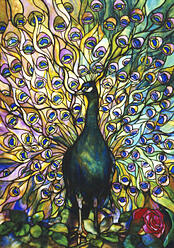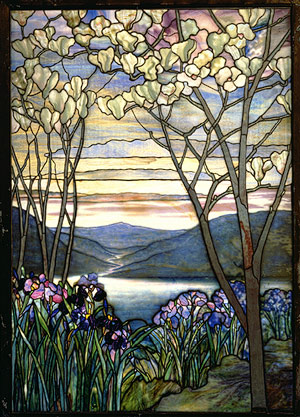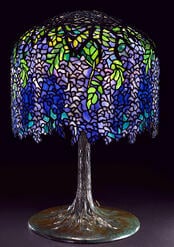How Did Louis Comfort Tiffany Contribute to Art Nouveau Style?
No artist's panoply of work can exist separated from the civilisation of the time in which they lived. Louis Comfort Tiffany was particularly fortunate to be born, with talent, into a wealthy family unit, but his monumental success was non only due to the circumstances of his birth; he likewise owed much to the American spirit, and optimism of the era. For this was a time when old styles and influences were washed abroad, and artists challenged historicism – and the deadening repetition of tradition in art. As one century drew to a close a proliferation of ideas emerged to welcome in the next one and artists benefited every bit wealthy patrons bestowed commissions in their desire to be at the vanguard of culture. The fine art industry of Tiffany came to epitomize much of the glory of the 'new art', or Art Nouveau, which reached its apotheosis from 1880 to 1910. This creative entrepreneur is regarded as a herald of the new motion, whose large body of piece of work spanned a number of decades, a variety of materials and media – and encompassed many of the artful values of the mean solar day. Tiffany's work and his beliefs were not confined to this movement, notwithstanding, and have stood the examination of fourth dimension, to exist enjoyed past new generations who curiosity at the intricacy of his designs and the effeminateness of his impact. Tiffany declared that his goal was the 'pursuit of dazzler' and he was able to engage in this singular aim by means of a range of arts and crafts. His personal qualities of drive, ambition, creativity and commercial acumen equipped Tiffany well, and he was able to experiment in painting, interior pattern, ceramics, enamelling, jewellery and mosaics throughout his career. It was his incomparable talent with glass, notwithstanding, for which Tiffany shall ever be best remembered. This challenging medium was ripe for change in the 1870s, equally traditionalists stuck firmly to the long-practised methods of painting enamel on articulate, uniformly coloured glass. After years of experimentation, Tiffany patented a series of revolutionary techniques in glass-making: techniques that enabled the glass artist to play with integral colours and textures, creating new types of hand-blown glass which Tiffany named 'Favrile'. Opalescent glass was created, which contained a variety of colours and hues within, offering a range of artistic opportunities for the glass-maker. New, three-dimensional effects were achieved by layering different colours of glass, and including delicate ornamentation between the layers. By adding metal salts to molten drinking glass Tiffany also achieved iridescence in his glassware which, with its shimmering lustre and rich vibrant palette of blues and greens, captured people's imaginations. Every piece of a leaded window was a unique example of color shot through glass, and captured the mercurial way that changing low-cal in nature plays with our perceptions. Tiffany's windows were living works of art; as daylight expressed its fickle moods, so the glass'due south visual brandish was transformed. He used these same techniques to produce a large range of lampshades which proved to be enormously popular with the American public. Themes from nature provided motifs for the shades, from poppies and wisteria to dragonflies and peacocks. Nature played a full part in all of Tiffany's piece of work; it was to be his primary inspiration throughout a long career. He designed and congenital huge gardens where he could relish nature's blessings and study the varieties of colour and shape that informed his piece of work. Some of his nigh exquisite manus-diddled vessels of Favrile glass, for example, bear the course and colours of frail plants opening in bloom. One of the virtually famous pieces of Tiffany art jewellery is a hair decoration that features a pair of enamelled and bejewelled dragonflies perched atop the puffballs of dandelions in seed. The puffballs are made from a fine mesh of gold wire that is sprinkled with tiny beads of opalescent glass: Tiffany had combined many elements of his art and craft manufacture to produce a single, unique piece of art. The Foundation still exists, however, and awards grants to young artists of talent. Tiffany'due south greatest legacy, however, is his art. Although many items were destroyed when fashions changed, and his glassworks fell from favour, much remains. In his pursuit of Beauty Tiffany provided united states, and generations beyond, with spectacles in lite and colour; he showed how the invaluable skills of craftsmen and women can be used to capture nature and, equally he put it 'obtain the revelation of True Beauty'. Tiffany's skill every bit a colourist and a craftsman led him to create works that still inspire artists and audiences today. The above is an excerpt from Louis Condolement Tiffany Masterworks (ISBN: 9780857752680) by Camilla de la Bedoyere. Read more near Tiffany on the Metropolitan Museum of Art's website here Await at some stunning Tiffany works on this pinterest board hither You lot tin buy products with Tiffany's peacock pattern from our Art of Fine Gifts range; such equally an iPhone case here or a luxury notebook here  Art Nouveau artist Louis Comfort Tiffany was highly skilled in jewellery blueprint, ceramics, enamels, and metalwork merely he is best known for his beautiful stained-glass designs. Using opalescent drinking glass in a variety of colours and textures, he created a stunning range of gem-like Art Nouveau works.
Art Nouveau artist Louis Comfort Tiffany was highly skilled in jewellery blueprint, ceramics, enamels, and metalwork merely he is best known for his beautiful stained-glass designs. Using opalescent drinking glass in a variety of colours and textures, he created a stunning range of gem-like Art Nouveau works.A Production of His Time

The Pursuit of Beauty
Stunning Windows
 It was non only in colour that Tiffany worked keen changes; his leaded windows, for which he became particularly well-known, often featured figures from Biblical scenes, as required for his ecclesiastical commissions. Just, once he had mastered the creation of tone and shade within glass, Tiffany began to paint pictures with glass, producing boggling visions in light and color without the demand for a figurative focus. Stunning scenes of landscapes, cascading morning glories, ivy and clematis won approval from clients and critics alike; Tiffany's work was recognized as a spectacular fusing of fine art and arts and crafts in i medium.
It was non only in colour that Tiffany worked keen changes; his leaded windows, for which he became particularly well-known, often featured figures from Biblical scenes, as required for his ecclesiastical commissions. Just, once he had mastered the creation of tone and shade within glass, Tiffany began to paint pictures with glass, producing boggling visions in light and color without the demand for a figurative focus. Stunning scenes of landscapes, cascading morning glories, ivy and clematis won approval from clients and critics alike; Tiffany's work was recognized as a spectacular fusing of fine art and arts and crafts in i medium.Nature'due south Design
A Lasting Legacy
 Throughout his career Louis C. Tiffany sought a unity of blueprint in the house's output, and a quality of craftsmanship from his skilled team of employees. He was successful in serving society'south elite with prestigious objects of desire, and also used early methods of mass product to make 'fancy goods' for the less wealthy. By the 1920s Tiffany had enjoyed many years' success, nationally and internationally, and sought to prepare his legacy by the means of a Foundation, museum and fine art school, established in his beloved country home, Laurelton Hall. Sadly, the school closed and the Hall burned down in 1957, destroying many of Tiffany's finest windows.
Throughout his career Louis C. Tiffany sought a unity of blueprint in the house's output, and a quality of craftsmanship from his skilled team of employees. He was successful in serving society'south elite with prestigious objects of desire, and also used early methods of mass product to make 'fancy goods' for the less wealthy. By the 1920s Tiffany had enjoyed many years' success, nationally and internationally, and sought to prepare his legacy by the means of a Foundation, museum and fine art school, established in his beloved country home, Laurelton Hall. Sadly, the school closed and the Hall burned down in 1957, destroying many of Tiffany's finest windows.Links

Source: http://blog.flametreepublishing.com/art-of-fine-gifts/bid/73246/Art-Nouveau-Artists-Louis-Comfort-Tiffany
0 Response to "How Did Louis Comfort Tiffany Contribute to Art Nouveau Style?"
Post a Comment